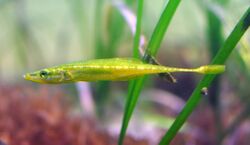Biology:Spinachia spinachia
| Spinachia spinachia | |
|---|---|

| |
| Sea Stickleback (Spinachia spinachia) | |
| Scientific classification | |
| Kingdom: | |
| Phylum: | |
| Class: | |
| Order: | |
| Family: | |
| Genus: | Spinachia G. Cuvier, 1816
|
| Species: | S. spinachia
|
| Binomial name | |
| Spinachia spinachia | |
| Synonyms | |
| |
The sea stickleback (Spinachia spinachia), also known as the fifteen-spined or fifteenspine stickleback, is a species of stickleback which lives in benthopelagic and in brackish environments of the northeastern Atlantic Ocean. This species, the largest of the sticklebacks, grows to a length of 22 centimetres (8.7 in) SL. This species is the only known member of its genus Spinachia. It is of no interest as a commercial fish.
Description
The fifteen-spined stickleback is an elongated fish with a long slender snout, an elongated caudal peduncle about one third of the total length, and a fan-like rounded caudal fin. The anterior dorsal fin consists of a series of fourteen to fifteen small, widely separated spines. The posterior dorsal fin and the anal fin are aligned and are similar in size and shape and located immediately anterior to the caudal peduncle. The pelvic fins consist of spines. This fish is brownish-yellow with indistinct dark markings and a silvery belly.[2] It grows to a maximum size of 22 centimetres (8.7 in), [3] but the usual size range is 8 to 15 cm (3 to 6 in).[2]
Distribution and habitat
The fifteen-spined stickleback is native to coastal waters in the northeastern Atlantic Ocean where it lives among bladderwrack and eel grass.[3]
Biology
The fifteen-spined stickleback is a solitary fish and a predator that lurks among concealing vegetation ready to pounce on plankton and fish fry which drift too close. Breeding takes place in May and June among bladderwrack, with males building nests out of bits of seaweed, and guarding and fanning the eggs with his fins until they hatch. The males continue to care for the fry until they have absorbed the contents of their egg yolks and can feed for themselves. It is thought that adults die after spawning.[2]
References
- ↑ "Spinachia spinachia". IUCN Red List of Threatened Species. https://www.iucnredlist.org/species/18257762/19929494.
- ↑ 2.0 2.1 2.2 "Fifteen-spined stickleback: Spinachia spinachia". NatureGate. http://www.luontoportti.com/suomi/en/kalat/fifteen-spined-stickleback. Retrieved 2013-12-17.
- ↑ 3.0 3.1 "Fifteenspined stickleback (Spinachia spinachia)". Fishes of the NE Atlantic and the Mediterranean. Marine Species Identification Portal. http://species-identification.org/species.php?species_group=fnam&id=1475. Retrieved 2013-12-17.
External links
Wikidata ☰ Q1545914 entry


